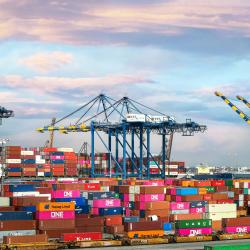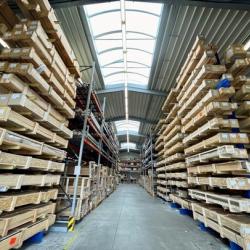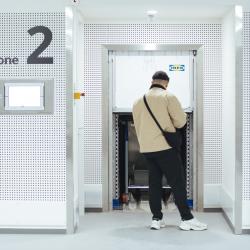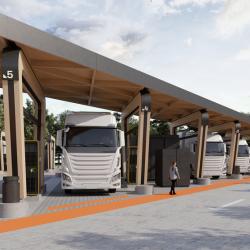The dream of all logistics experts: Each delivery simply works
How the start-up Green Convenience wants to guarantee successful deliveries.
DragonImages / Envato Elements
The multiple individual deliveries to end customers are problematic. They consume resources, pollute the environment and clog the streets. If continual delivery attempts by providers or consumers’ parcel pick-ups by car are added to this, the problem increases.
The Frankfurt-based start-up Green Convenience wants to tackle this challenge and ensure that the first delivery almost always works - and without monitoring. Benjamin Dauth, CEO and co-founder, explains to us how they envision this and are already trying it out.
Benjamin, why is an efficient last mile so important?
The last mile causes the most costs and emissions in B2C logistics. This phenomenon, long known and well studied in logistics research, is often referred to as the "Last Mile Problem".

What are common problems in delivery to end customers?
According to the average of six international studies, 19.7% of delivery attempts fail due to the absence of recipients - rounded up, that's one in five delivery attempts,. The result is repeated delivery attempts or warehousing with parcel pick-up trips by consumers.
Often, people try to avoid this problem by agreeing on delivery windows, which leads to other problems. Consumers do not like to wait, so long delivery windows put a strain on customer relations. But short delivery windows lead to inefficient delivery routes and are harder to meet. According to a mathematical model from the University of Antwerp, failed delivery attempts and inefficiencies due to short delivery windows are responsible for 45% of B2C delivery costs and emissions on average.
There are a variety of solutions, but none of them ensure the direct delivery demanded by consumers. According to an international McKinsey study, the average consumer would only give up direct delivery in exchange for savings of more than three US dollars.
How does your solution help solve this delivery problem?
Green Convenience automatically ensures successful first delivery attempts.
The solution uses Big Data analytics to determine core attendance periods at delivery addresses for the next few days - and does so individually for each delivery address. (Neighboring households can also be taken into account.) Until delivery, the system carries out continuous updates and corrects itself if necessary. The solution can be easily integrated into delivery systems. The success of the first delivery attempt can thus be ensured automatically.
How does this work technologically and what data sources do you use?
Our solution is a mix of AI-based Big Data analytics and extensive data protection and security technology. The AI analyzes various data sources and detects patterns. Our predictions are not based on information about when a delivery was successful in the past, but on presence at the delivery address. For a delivery time in three days, they have a reliability of 90%. and become more reliable the closer the delivery gets, as the system continuously optimizes itself. The central data sources and the operation of the technology used are confidential. They are supplemented by other information such as weather data, days of the week or regional holidays; these are not essential, but improve the results.
How long does it take to have the information for a reliable database for an area?
The system will be at full capacity after a period of data collection of three months.
Won't this condense delivery times enormously because statistically most people are at home in the evening?
It is important to note that our solution does not simply calculate when most people are at home in a particular area. Such very generic analyses already exist from other vendors. And you are right that such generic analyses will always show that most people are at home in the evening, which makes the analysis useless for deliveries.
Our system predicts at-home presence individually on a household basis. This means: it predicts the time periods when usually at least one person is always present in a household. If optionally a neighboring household is added in the calculation, it predicts the time periods when usually at least one person is always present at the delivery address or in the neighboring household. And these results vary greatly from household to household, making them extremely valuable.
Is your technology already in use?
We have successfully tested the solution in collaboration with our partner "Self Organizing Systems Lab" at the TU Darmstadt. Testing in delivery operations will be done in collaboration with HTW Berlin, TU Darmstadt, various logistics companies and other partners. We are very grateful for the extensive support and for the fact that interested companies are approaching us.
This all sounds like a small revolution. What is your vision for the last mile?
Our vision is that in the future the first delivery attempt will always succeed automatically. Repeated delivery attempts and parcel pick-up trips by consumers will only be reminders. This will reduce traffic, emissions and costs while improving the customer experience. End customers will expect and require this service.
What challenges do you see for the whole issue of last-mile logistics? What needs to happen and what will happen?
The main reason why B2C e-commerce exists is the desire for convenience. Consumers will always include the delivery experience in their decision where to shop. In our experience, this empirically proven fact is often neglected or overridden by wishful thinking in approaches to last mile solutions. The bitter pill that consumers will not lower their expectations of price and convenience, but increase them, is not to everyone's taste.
Attempts to re-educate consumers to pick up their parcels will continue to fail in the majority of cases because the convenience of online ordering is missing. In addition, a parcel pick-up trip by consumers is no more environmentally friendly than a successful first delivery attempt by delivery services.
channels: e-commerce, logistics, delivery, artificial intelligence, environment, big data








